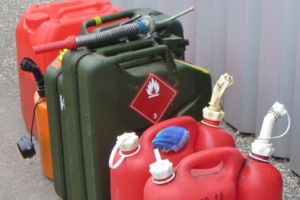Cheap Methods To Store Fuels

Making sure you have fuel (gasoline, diesel, kerosene, propane, etc) stored safely as part of your preparations for a long-term disaster is vital.
But fuel can also be a major expense, which is one reason why most people avoid storing large quantities of it.
Another reason is that many people also believe that making the preparations to store their fuels over the long term will be an even larger expense.
In reality, storing fuels is much cheaper and easier than you may have suspected.
Buying the fuel itself may not be cheap in this day and age, but storing that fuel inexpensively and in a way that is also safe is easily doable.
Here are cheap and safe methods for storing fuels:
Both the simplest and cheapest way to store fuels is in approved plastic containers.
You can find these containers at most general or sporting goods stores.
Plastic containers should be less expensive than metal containers as well.
Do a bit of research and you should be able to find fuel containers at garage sales or on eBay where you can buy them for even less money.
Related: 18 Vintage Homesteading Tools to Search for at Garage Sales
Always store fuels in containers that are approved for the specific fuel you are storing. They will be color coded as follows:
Remember to never fill fuel all the way up to the top of the container. Fuel will expand when it gets hot, so always make sure you leave a bit of room.
So now that you have your plastic containers collected and your fuel stored in them, the next question becomes: where do you store your containers?
You may think that you have to build an entirely new (and expensive) structure just to safely house your fuels. Nothing could be further than the truth.
Always try to store your fuels inside rather than outside. The structure you store your fuels should meet the following criteria:
A shed or garage that is detached from your house and is shaded by overarching trees or brush is the best location.
The next best location will be the garage attached to your house, provided again that the above qualifications are met.
Just remember to never store fuels inside your house. If the fumes end up leaking it will be dangerous in your home where they can’t escape.
What do you do if you don’t have a garage or shed that meets the above qualifications?
Simple: store the fuel outside. Just make sure you do so in an area that is perpetually shaded and then cover the containers with tarps or plastic sheeting.
If you don’t already have tarps or sheeting that you can use, you can buy them inexpensively.
Always use fuel stabilizers if you’re going to be storing fuel over the long term.
A container of fuel stabilizer can usually be purchased without spending an arm and a leg.
Fuel stabilizers are usually made from petroleum-based products.
They work to provide a protective layer for the fuel that sits inside the container. This is done to prevent the fuels from evaporating or to form a sticky residue.
Related: What’s the Best Fuel to Stockpile for Survival?
Gasoline and diesel in particular have a short shelf life. Gasoline will begin to degrade within one month and become bad after about six months, while diesel will start to degrade after a year.
By adding fuel stabilizer to gasoline or diesel, you can extend its shelf life to several years provided the aforementioned storage methods are met as well.
As a general rule, you’ll need a couple ounces of stabilizer for every five gallons of gasoline or diesel.
This is a little known trick that you can use to safely store your fuels if you have an old freezer (and a shovel) lying around.
If you have an old freezer, don’t throw it away. Instead, get more value out of it by repurposing it for fuel storage.
First, choose a shady location where you could bury the freezer just under ground.
Then drill two holes (on either end of the freezer) that can accommodate vent pipes approximately two inches in diameter. Place one pipe at one end and the other at the other end. Add screening to the vents if you can to prevent rodents from getting in.
Then take a shovel and dig a hole for the freezer. Place the freezer into the hole, and then place your gasoline containers into the freezer.
Proceed to cover the freezer with dirt, and then you can cover the vent pipes with foliage to camouflage it.
This method will almost eliminate the risk of the fuels becoming a fire hazard, and it will also ensure that everything is kept hidden. This is why this method can be beneficial at a survival cache or bug out location in particular.
This may be a multi-person job to successfully lift and lower the freezer into the hole, but it can make for a good Saturday afternoon project when you have the time.
To summarize:
Each of the above can be done without spending a fortune.
At the end of the day, you’re going to have to budget money to purchase and then properly store your fuels as part of your preparation. It just doesn’t have to be as expensive of an endeavor as you may have thought.
You may also like:
Best U.S. States To Forage For Food
This Homemade Device Can Power Up Your Entire House 7 Days in a Row (Video)
5 Vehicles That Can Handle An EMP Attack
Concealed Carry Mistakes You Have To Avoid At All Costs
